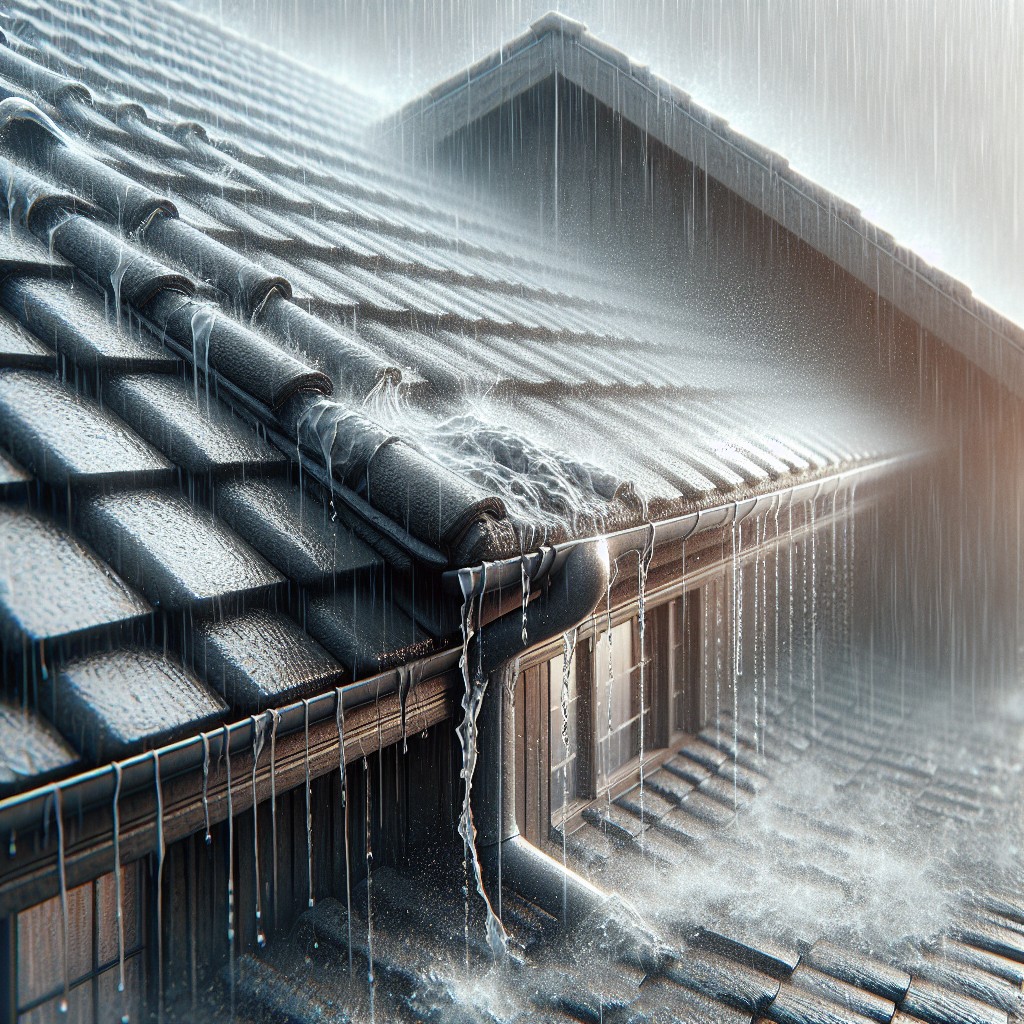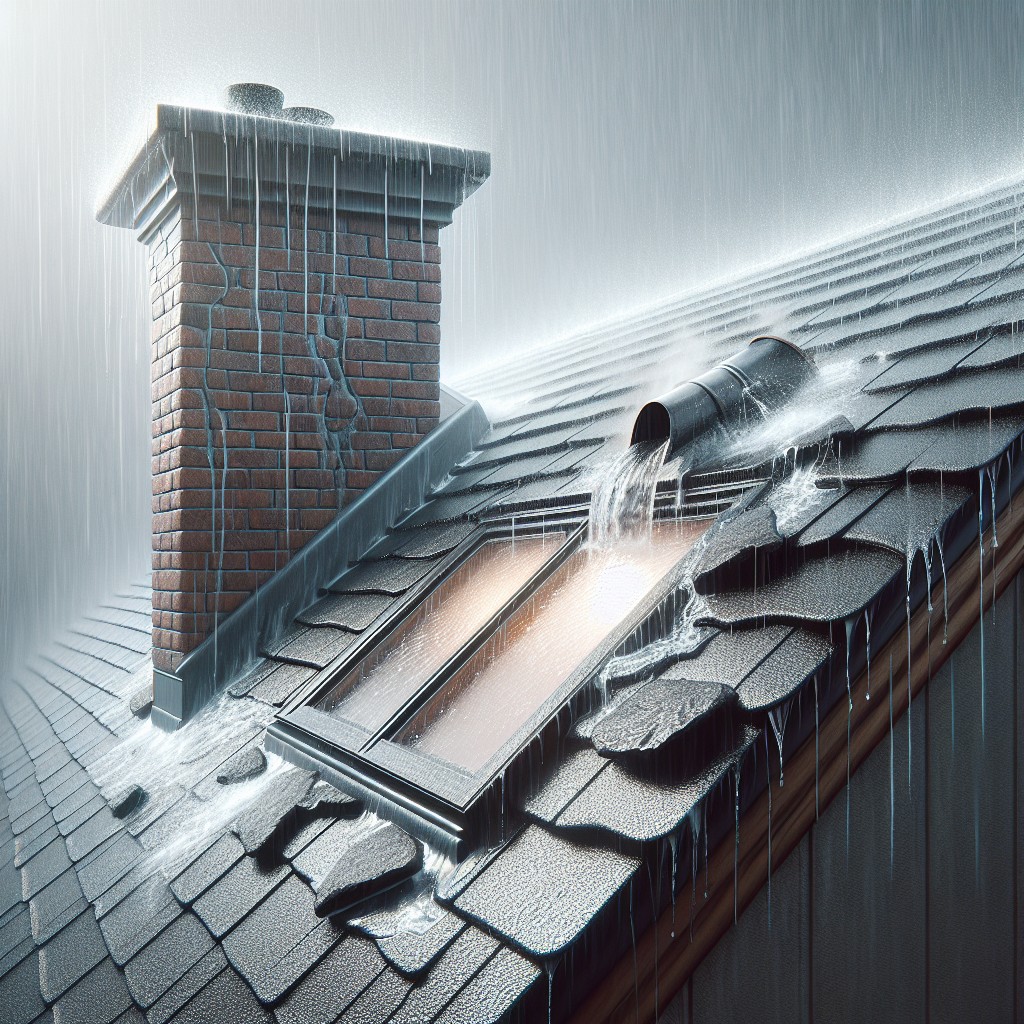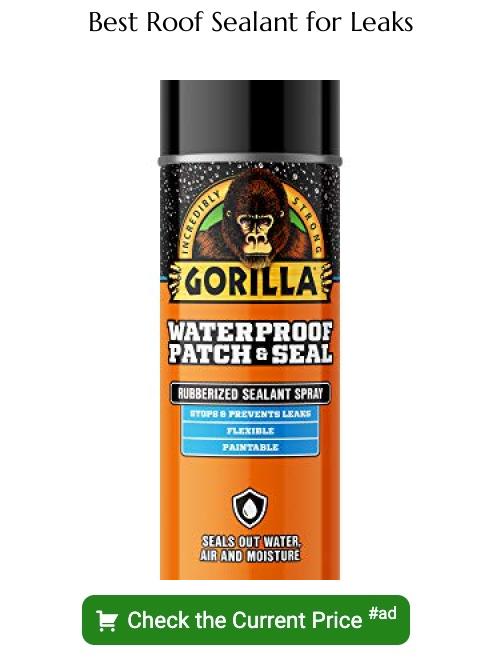Last updated on
Roofs often leak during heavy rain because there may be underlying issues that need addressing; this article aims to give you a comprehensive guide on identifying these problems and how to fix them.
Key takeaways:
- Aging roofs are more prone to leaks during heavy rain.
- Chimneys, skylights, and flashing are common leak points.
- Damaged flashing and shingles can lead to leaks.
- Clogged gutters and downspouts can cause water backup.
- Interior signs of leaks include stains, dampness, and odors.
Identifying the Cause of Roof Leaks in Heavy Rain

A roof leak during a heavy rainstorm can be both alarming and damaging. To identify the cause, start by examining the roof’s age—older roofs are more prone to leaks.
Next, consider the weather’s impact, as high winds can lift shingles, creating entry points for water. Additionally, look for worn, cracked, or missing shingles.
A well-sealed roof is your first line of defense; compromised sealants can give way under persistent downpours.
Lastly, do not overlook roof features; areas around chimneys, vents, and skylights are notorious for developing leaks, as their seals and flashing can deteriorate over time.
Identifying the cause swiftly is crucial to preventing further damage.
Chimney and Skylight Leaks

Chimneys and skylights add character and natural light to a home, yet they are common sites for leaks during heavy rain. These features often penetrate the roof surface, creating potential weak points where water can seep in. The flashing, which is the metal strip that seals the gap between the chimney or skylight and the roof, can deteriorate or become dislodged over time. In heavy rain, compromised flashing fails to redirect the water flow away, allowing moisture to penetrate the roof.
For chimneys, check the condition of the mortar joints, as these can crack and grind down, presenting another entrance for water. Similarly, skylights have seals that can degrade. These should remain pliable and intact; hardening or splitting indicates they’re due for replacement. It’s essential to inspect these elements regularly, particularly before the rainy season, to ensure they are watertight. A professional roofing contractor can assess and repair these specific areas, potentially saving homeowners from more extensive water damage.
Flashing and Shingle Issues
Flashing—the thin pieces of metal installed to prevent water from entering at joints—plays a critical role in safeguarding against leaks. When improperly installed or damaged, flashing can fail during heavy rains, allowing water to seep in. Routine inspections can spot rust, cracks, or breaks in this material.
Shingles also demand attention as they can crack, warp, or go missing, compromising the roof’s integrity. When shingles are loose or missing, the underlayment is exposed to the elements, increasing the risk of a leak. It’s essential to replace damaged shingles promptly to maintain an effective barrier against water.
During heavy rain, the volume and force of water hitting the roof can exacerbate any weak points. Therefore, post-storm checks are advisable, focusing on both flashing and shingles for signs of distress. Remember, a small breach can lead to significant water damage over time. Regular maintenance, especially after severe weather, is the key to keeping your roof in top condition.
Clogged Gutters and Downspouts
Properly functioning gutters and downspouts are essential to directing rainwater away from your roof. When they become clogged with leaves, twigs, and debris, water can back up and seep underneath roofing materials, potentially causing leaks. It’s particularly important to check these areas:
1. Regular Cleaning: Clean gutters and downspouts at least twice a year to prevent blockages. A gutter guard installation may reduce the frequency of cleanings needed.
2. Inspection for Damage: Look for signs of rust, holes, or separations in your gutters and downspouts. Even small defects can lead to water issues over time.
3. Proper Slope and Alignment: Ensure that gutters slope correctly towards downspouts for optimal water flow. Misaligned gutters can cause water to pool and eventually seep through the roof.
4. Downspout Discharge: Check that downspouts extend far enough away from your home to prevent water from pooling near the foundation, which could lead to further complications, including excess moisture entering the basement or crawl spaces.
By addressing these points, you help maintain the integrity of your roof’s drainage system, especially during heavy rains.
Interior Signs of a Leaking Roof
Water stains on ceilings and walls often signal a leaking roof. These stains may appear as discolored spots or dark rings, commonly growing in size during prolonged rain. Peeling paint or wallpaper can also be a symptom of moisture intrusion from a roof leak.
Another indicator is dampness around the fireplace; moisture in this area typically signifies issues with the chimney flashing. In attics or upper crawlspaces, look for wet insulation, which can reduce its effectiveness and contribute to energy loss.
Musty odors in certain rooms are a less visible but equally telling sign. These odors often originate from mold or mildew growth, which thrives in moist settings generated by roof leaks. Visible mold on ceilings or in attic spaces should prompt immediate inspection as it can indicate a long-standing moisture problem.
Lastly, if light fixtures or ceiling fans show signs of water inside, this points to a direct leak above, and immediate action is necessary to prevent electrical hazards.
How to Identify and Inspect Problem Areas
When inspecting your roof for potential leakage points, first examine the shingles for any signs of damage or wear, such as missing, cracked, or curled pieces. Pay particular attention to areas near roof penetrations, like vents and chimneys, where flashing is essential in preventing water entry. Check for rust or holes in the metal flashings.
Gutters and drainage systems should be cleared of debris to ensure water flows freely and does not pool on the roof. Inside the attic, lookout for damp rafters or insulation and stains on the ceiling, which indicate water seepage. Use a flashlight to check for glistening moisture along the underside of the roof sheathing.
Lastly, inspect seals around skylights and other fixtures. These areas should be intact and not show signs of cracks or breaks that could allow water to enter during heavy rains. If any potential problem areas are identified, prompt action is advised to prevent more extensive damage.
The Importance of Regular Roof Maintenance
Regular upkeep is essential to extending the lifespan of your roof and preventing leaks, especially during heavy rainfall. Here are a few key reasons why:
1. Early Detection: Routine checks can reveal minor damages before they escalate into significant problems.
2. Prevents Build-Up: Debris can accumulate and cause water to pool on your roof; maintenance clears out these potential blockages.
3. Seal Integrity: Inspections can ensure that the seals around vents and chimneys remain intact, preventing water ingress.
4. Gutter Care: Clean gutters allow rainwater to flow freely, avoiding water backup under roofing materials.
5. Moss and Algae Control: Addressing any growth early on avoids the deterioration of roofing materials.
6. Warranty Preservation: Many warranties require regular maintenance to remain valid.
Addressing the needs of a roof through planned maintenance can fend off emergency repairs and the associated stress and costs that accompany them.
Hiring a Professional Roofing Contractor
When contracting a professional, seek those with verifiable credentials and insurance to ensure quality work and liability coverage. Experience matters, as seasoned contractors are likely to spot less obvious issues that can lead to leaks.
Obtain multiple quotes to compare services and prices, but be wary of estimates that are significantly lower than others, as this could indicate subpar workmanship. Check reviews and ask for references to gauge the contractor’s reputation and reliability.
Clear communication is crucial: A reputable professional will explain the necessary repairs and provide a detailed contract, avoiding unexpected costs or misunderstandings. Lastly, a good contractor should offer a warranty for their work, giving you peace of mind and protection in case of future issues.
Assessing the Need for Roof Repair or Replacement
Determining whether to repair or replace a roof involves a few critical considerations. Firstly, the age of your roof plays a major role; if it’s nearing the end of its expected lifespan, replacement may be the prudent choice. Secondly, the extent of damage is crucial; widespread issues often warrant a new roof, while isolated leaks might be addressed with repairs.
Additionally, evaluate the frequency of leaks; recurrent problems could signal underlying structural issues. Factor in the long-term costs as well; repeated repairs may be more expensive over time than investing in a new, more durable roof. Finally, consult with a licensed roofing professional to inspect the roof and provide expert advice tailored to your situation.
Cost Considerations for Roof Leak Repairs
Understanding the financial implications of roof leak repair is crucial for homeowners.
Extent of Damage: Minor leaks typically involve lower costs, while extensive water damage can significantly increase expenses.
Materials Required: High-end materials, such as copper flashing, will have a higher price tag than standard options like galvanized steel.
Labor Costs: Skilled labor is required for proper repairs; therefore, regions with higher labor rates may see increased costs.
Complexity of Repair: Simple repairs, such as replacing a few shingles, are less costly compared to addressing structural issues that require more time and expertise.
Roof Accessibility: Difficulty in accessing the roof, due to slope or height, can add to the repair costs due to the additional safety measures and equipment needed.
Preventative Measures: Investing in preventative measures, such as better quality materials or additional waterproofing, can add to the upfront cost but save money in the long run by preventing future leaks.
When budgeting for repairs, it is wise to obtain multiple quotes from reputable contractors to ensure a fair price for the needed work.
FAQ
How do you stop a leaking roof during heavy rain?
To stop a leaking roof during heavy rain, cover the affected area with a tarp, anchoring it securely with heavy concrete blocks and ensuring it extends over the ridge to remain in place even amid severe storms.
Why is my house leaking water after heavy rain?
Your house could be leaking water after heavy rain due to cracks around flashings, improper roofing materials, dirty gutters, or lack of a proper waterproofing membrane.
Is a leaking roof an emergency?
A leaking roof is considered an emergency if it severely damages your home to the point of being uninhabitable or if the structure is exposed to the elements.
What are the common causes of roof leaks during heavy rains?
Common causes of roof leaks during heavy rains include loose, broken or missing shingles, improperly sealed valleys, cracked vent booting, and damaged or deteriorated flashing.
How can regular roof maintenance prevent leaks during heavy precipitation?
Regular roof maintenance can prevent leaks during heavy precipitation by ensuring the proper functioning of gutters, checking for potential vulnerabilities like missing or worn-out shingles, and by sealing off any cracks or holes in the roof structure.
Can severe weather conditions like heavy rains cause permanent damage to your roof?
Yes, severe weather conditions such as heavy rains can cause permanent damage to your roof.





